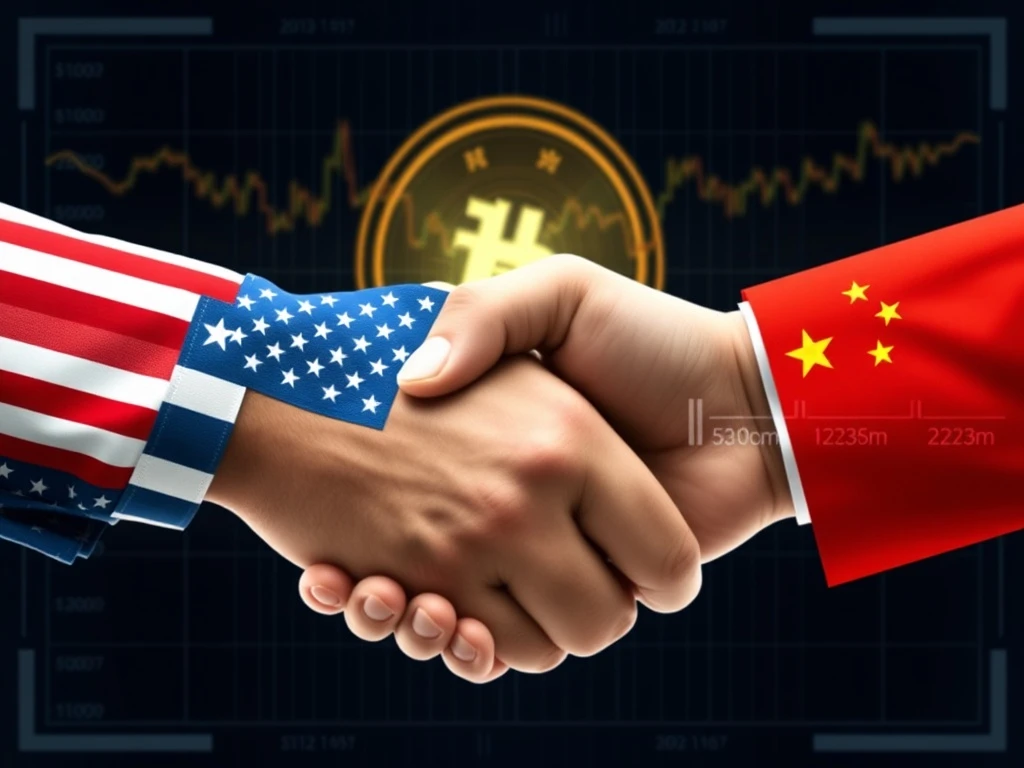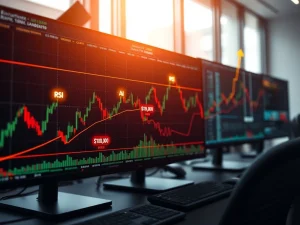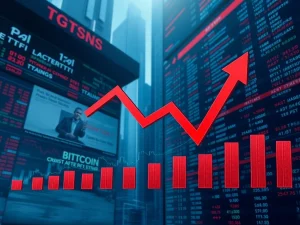Bitcoin’s Resilience: US-China Tariff Truce Extends, Calming Global Markets

In a significant development for global commerce and financial markets, the United States and China have once again extended their tariff truce by another 90 days. This pivotal agreement, reached during high-level negotiations in Stockholm, aims to provide a much-needed buffer period for resolving deep-seated trade disputes. For cryptocurrency enthusiasts and investors, the immediate question is: what does this mean for the Bitcoin price and the broader digital asset landscape? While the truce offers temporary relief from escalating trade tensions, its impact on the volatile crypto market is proving to be a nuanced story, highlighting the evolving dynamics that influence digital assets.
Understanding the US-China Tariff Truce: A Temporary Calm in the US China Trade War
The extension of the tariff truce between the U.S. and China represents a critical pause in what has been a tumultuous period for global trade. Led by U.S. Treasury Secretary Scott Bessent and Chinese Vice Premier He Lifeng, these negotiations are the third high-level meeting in recent months, signaling a mutual desire to de-escalate immediate tensions. The primary goal of this 90-day extension is to delay the imposition of new tariffs, thereby creating a window for more comprehensive discussions aimed at resolving broader trade and geopolitical issues.
- De-escalation of Tariffs: The agreement prevents immediate new tariffs, which had previously threatened to further strain global supply chains and increase costs for consumers and businesses.
- Dialogue Window: It provides a crucial 90-day period for negotiators to delve into complex issues like intellectual property rights, state subsidies, and technology transfers.
- Market Reassurance: The truce offers a degree of certainty to global markets, which have historically reacted sharply to escalations in the trade war.
While described as “constructive” by both sides, the underlying issues that fueled the US China trade war remain largely unresolved. This extension, therefore, acts more as a temporary sedative for anxious markets rather than a definitive cure for long-standing economic friction.
Bitcoin Price: A Measured Response to Global Stability?
Historically, significant geopolitical developments, particularly those affecting global trade, have often sent ripples through the cryptocurrency markets. The expectation for a robust reaction from the Bitcoin price following the tariff truce extension was understandable, given past instances where reduced trade uncertainty correlated with increased speculative investment in crypto assets.
However, the immediate impact on Bitcoin (BTC) has been surprisingly muted. While Bitcoin did see a modest surge of approximately 1-2% in the days leading up to the announcement, no significant or sustained shifts in crypto trading volumes have been observed post-decision [2]. This contrasts with previous tariff extensions, which sometimes saw Bitcoin approach record highs amid diminished trade-related uncertainty.
Why the muted reaction this time?
- Anticipation Priced In: The market might have largely priced in the likelihood of an extension, reducing the element of surprise.
- Focus on Macro Indicators: Cryptocurrency markets are increasingly sensitive to broader macroeconomic conditions, such as inflation, interest rates, and regulatory developments, rather than solely trade news.
- Temporary Nature: Investors may view this 90-day truce as a temporary reprieve, not a permanent resolution, leading to cautious optimism rather than aggressive buying.
This measured response underscores the growing maturity of the crypto market, which is now more attuned to fundamental shifts in monetary policy and regulatory clarity than solely reacting to every geopolitical headline.
Ensuring Crypto Market Stability: Beyond Trade Deals
The concept of crypto market stability is a complex interplay of various factors, and the US-China tariff truce highlights that trade relations are just one piece of a much larger puzzle. While reduced geopolitical uncertainty can generally foster a risk-on environment beneficial for assets like Bitcoin and Ethereum, the current market dynamics suggest other forces are at play.
Ethereum (ETH), for instance, much like Bitcoin, has not shown significant price movement directly tied to the truce extension [3]. This reflects a broader trend where crypto markets are increasingly prioritizing:
- On-Chain Activity: The health and growth of decentralized finance (DeFi), NFT ecosystems, and overall network utility.
- Regulatory Clarity: Progress on clear regulatory frameworks in major jurisdictions.
- Monetary Policy: Decisions by central banks regarding interest rates and quantitative easing/tightening.
- Technological Advancements: Major upgrades or breakthroughs within blockchain ecosystems.
While the tariff truce contributes to a less volatile global economic backdrop, it doesn’t directly address the internal drivers that foster long-term crypto market stability. Investors are looking for more than just the absence of bad news; they are seeking positive catalysts from within the crypto space itself.
The Broader Global Economic Impact: A Cautious Outlook
Beyond the immediate implications for digital assets, the extended tariff truce carries significant weight for the broader global economic impact. The initial 145% tariffs on U.S. imports and 125% tariffs on Chinese goods have already strained global manufacturing and tech sectors. Companies reliant on cross-border logistics have been forced to re-evaluate supply chains, facing increased costs and uncertainties [3].
The 90-day reprieve offers a temporary breathing room, allowing businesses to adjust inventory strategies and production plans without the immediate threat of new tariff hikes. This is particularly crucial for industries deeply intertwined with both economies, such as:
- Electronics Manufacturing: Heavily reliant on components from both nations.
- Automotive Sector: Global supply chains for parts and finished vehicles.
- Agricultural Exports: A key point of contention in previous negotiations.
However, experts warn that the truce’s long-term efficacy is limited by the fact that core issues—such as intellectual property disputes, forced technology transfers, and export controls on advanced technologies—remain unresolved [6]. These deep-seated structural issues are far more complex than simple tariff adjustments and require sustained, committed negotiations.
The absence of immediate escalation is a welcome change from earlier phases of the trade war, where tariff announcements triggered sharp market swings. Yet, the extension does not guarantee a resolution, and prolonged tensions still pose threats to global trade and investment flows, casting a shadow of uncertainty over the future global economic impact.
Navigating the Tariff Truce: What Investors Should Watch For
For investors, the extended tariff truce presents a period of cautious observation. While it removes an immediate downside risk from escalating trade tensions, it also doesn’t provide a strong bullish catalyst for risk assets like cryptocurrencies. Here’s what to consider:
Key Takeaways from the Truce:
- Temporary Relief: It’s a pause, not a resolution. The underlying structural issues between the U.S. and China persist.
- Market Stability: The truce has reduced immediate volatility in traditional markets, which indirectly benefits crypto by reducing macro headwinds.
- Muted Crypto Reaction: The crypto market’s subdued response suggests its focus has shifted from geopolitical trade news to internal market dynamics and broader macroeconomic factors.
What to Watch For Next:
- Further Negotiations: The success or failure of the next rounds of talks will be critical. Concrete policy frameworks are needed.
- Economic Data: Inflation reports, interest rate decisions by central banks, and GDP growth figures will likely have a more direct impact on crypto prices.
- Regulatory Developments: Upcoming regulations in key markets (e.g., U.S., EU, Asia) will continue to shape investor sentiment and institutional adoption.
- On-Chain Metrics: Pay attention to active addresses, transaction volumes, and DeFi TVL (Total Value Locked) as indicators of organic growth within the crypto ecosystem.
The current environment calls for a balanced approach, acknowledging the temporary calm provided by the truce while remaining vigilant about the unresolved issues and the primary drivers influencing cryptocurrency valuations.
Conclusion: A Breath of Fresh Air, Not a Clear Horizon
The 90-day extension of the U.S.-China tariff truce offers a welcome, albeit temporary, reprieve for global markets. It successfully averts immediate escalation, fostering a period of cautious optimism and providing businesses with much-needed predictability. While the Bitcoin price and the broader crypto market have reacted with a measured calm rather than a dramatic surge, this response underscores their increasing sensitivity to deeper macroeconomic currents and internal industry developments.
This truce is a testament to ongoing dialogue, but it does not erase the fundamental disagreements that continue to define the relationship between the world’s two largest economies. For investors, the takeaway is clear: enjoy the temporary stability, but keep a close eye on the ongoing negotiations, broader economic indicators, and the ever-evolving landscape of cryptocurrency regulation and innovation. The journey towards a truly stable global economic and crypto market environment is far from over.
Frequently Asked Questions (FAQs)
Q1: What is the significance of the U.S.-China tariff truce extension?
A1: The 90-day extension signifies a mutual effort by the U.S. and China to de-escalate trade tensions by delaying new tariffs. It provides a crucial window for further negotiations aimed at resolving long-standing trade disputes, offering temporary stability to global markets and supply chains.
Q2: How has the Bitcoin price reacted to this truce?
A2: The Bitcoin price has shown a relatively muted reaction. While there was a modest 1-2% surge leading up to the announcement, no significant or sustained shifts in trading volumes were observed post-decision. This suggests the market may have already priced in the extension or is more focused on other macroeconomic and regulatory factors.
Q3: Why is the cryptocurrency market’s reaction different from past trade truce extensions?
A3: The current muted reaction indicates a shift in the crypto market’s primary drivers. It is now more influenced by broader macroeconomic conditions (like interest rates and inflation), regulatory developments, and on-chain activity within the crypto ecosystem, rather than solely reacting to geopolitical trade news.
Q4: What are the unresolved issues between the U.S. and China despite the truce?
A4: Key unresolved issues include intellectual property disputes, forced technology transfers, state subsidies, and export controls on advanced technologies. The truce only delays new tariffs; it does not address these deeper structural problems that continue to define their trade relationship.
Q5: What should investors watch for regarding the global economic impact?
A5: Investors should monitor the progress of future U.S.-China negotiations for concrete policy frameworks. Additionally, keep an eye on global economic data (inflation, GDP, interest rates) and significant regulatory developments in the crypto space, as these are increasingly influencing market movements.










